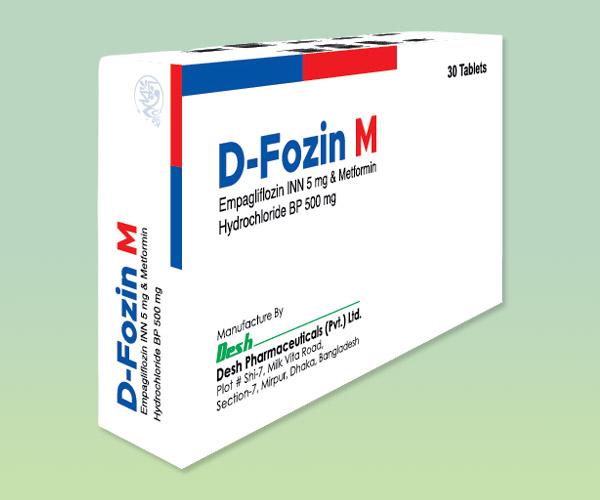D-Fozin M Tablet
Empagliflozin INN & Metformin Hydrochloride BP
D-Fozin M Tablet
Empagliflozin INN & Metformin Hydrochloride BP
Composition
Each film coated tablet contains Empagliflozin INN 5 mg + Metformin Hydrochloride BP 500 mg.
- AVAILABILITY: AVAILABLE
Pharmacology
This product combines two antihyperglycemic agents with complementary mechanisms of action to improve glycemic control in patients with type 2 diabetes: Empagliflozin, a Sodium-glucose co-transporter 2 (SGLT2) inhibitor, and Metformin Hydrochloride, a member of the biguanide class. Sodium-glucose co-transporter 2 (SGLT2) expressed in the proximal renal tubules, is responsible for the majority of the reabsorption of filtered glucose from the tubular lumen. By inhibiting SGLT2, Empagliflozin reduces the reabsorption of filtered glucose and lowers the renal threshold for glucose (RTG), thereby increasing urinary glucose excretion. The pharmacologic mechanism of action of Metformin is different from other classes of oral antihyperglycemic agents. Metformin decreases hepatic glucose production, decreases intestinal absorption of glucose, and increases peripheral glucose uptake and utilization.
Indication
It is indicated as an adjunct to diet and exercise to improve glycemic control in adults with type 2 diabetes.
Dosage & administration
Individualize the starting dose of the product based on the patient’s current regimen. The maximum recommended dose is 15 mg of Empagliflozin/1000 mg of Metformin twice daily.
Take twice daily with meals, with gradual dose escalation to reduce the gastrointestinal side effects due to metformin. Assess renal function before initiating the product.
Contraindication
For Empagliflozin:
Empagliflozin is contraindicated in patients with a history of serious hypersensitivity reaction to Empagliflozin or any of its ingredients, severe renal impairment, end-stage renal disease, or dialysis.
For Metformin:
Hypersensitivity to metformin or any of the excipients. Acute or chronic metabolic acidosis, including diabetic ketoacidosis, with or without coma. Renal disease or renal dysfunction e.g., as suggested by serum creatinine levels / abnormal creatinine clearance.
Warnings and precautions
Lactic acidosis, Hypotension, Ketoacidosis, Acute kidney injury and impairment in renal function, Hyperkalemia, Urosepsis and Pyelonephritis, Hypoglycemia, Genital mycotic infections, Hypersensitivity reactions, Bone fracture, Vitamin B1 deficiency. The risk of necrotizing fasciitis of the perineum/Fournier’s gangrene.
Side effects
For Empagliflozin:
The most common adverse reactions associated with Empagliflozin are urinary tract infections and female genital mycotic infections. Other common side effects include dehydration, hypotension, weakness, dizziness and increased thirstiness.
For Metformin:
Gastrointestinal symptoms-nausea, vomiting, diarrhoea, abdominal pain and loss of appetite are very common.
Use in pregnancy, lactation, childhood and elderly
Pregnancy:
There are no adequate and well-controlled studies of the Empagliflozin & Metformin combination in pregnant women. This combination should be used during pregnancy only if the potential benefit justifies the potential risk to the fetus.
Lactation:
It is not recommended when breastfeeding.
Pediatric use:
The safety and effectiveness of the Empagliflozin & Metformin combination in pediatric patients under 18 years of age have not been established.
Geriatric use:
Because renal function abnormalities can occur after initiating Empagliflozin, metformin is substantially excreted by the kidney, and ageing can be associated with reduced renal function, monitor renal function more frequently after initiating the product.
Drug interactions
For Empagliflozin:
Diuretics: Co-administration of Empagliflozin with diuretics resulted in increased urine volume. Insulin or Insulin Secretagogues: Co-administration of Empagliflozin with insulin or insulin secretagogues increases the risk for hypoglycemia. Positive Urine Glucose Test: Monitoring glycemic control with urine glucose tests is not recommended in patients taking SGLT2 inhibitors as SGLT2 inhibitors increase urinary glucose excretion and will lead to positive urine glucose tests. Use alternative methods to monitor glycemic control. Interference with 1,5-anhydroglucitol (1,5 AG) Assay: Monitoring glycemic control with 1,5-AG assay is not recommended as measurements of 1,5-AG are unreliable in assessing glycemic control in patients taking SGLT2 inhibitors. Use alternative methods to monitor glycemic control.
For Metformin:
No information is available about the interaction of Metformin and furosemide when co-administered chronically. Nifedipine appears to enhance the absorption of Metformin. Metformin had minimal effects on nifedipine. Cationic drugs (e.g., amiloride, digoxin, morphine, procainamide, quinidine, quinine, ranitidine, triamterene, trimethoprim, or vancomycin) that are eliminated by renal tubular secretion theoretically have the potential for interaction with Metformin by competing for common renal tubular transport systems. Metformin had no effect on cimetidine pharmacokinetics. Certain drugs tend to produce hyperglycemia and may lead to loss of glycemic control. These drugs include thiazides and other diuretics, corticosteroids, phenothiazines, thyroid products, estrogens, oral contraceptives, phenytoin, nicotinic acid, sympathomimetics, calcium channel blocking drugs, and isoniazid.
Storage
Store in a cool, dry place below 25 °C and protect from light. Keep out of reach of children.
Packing
D-fozin M Tablet: Box containing 2x10 / 3x10 / 5 x10 tablets in blister pack.
